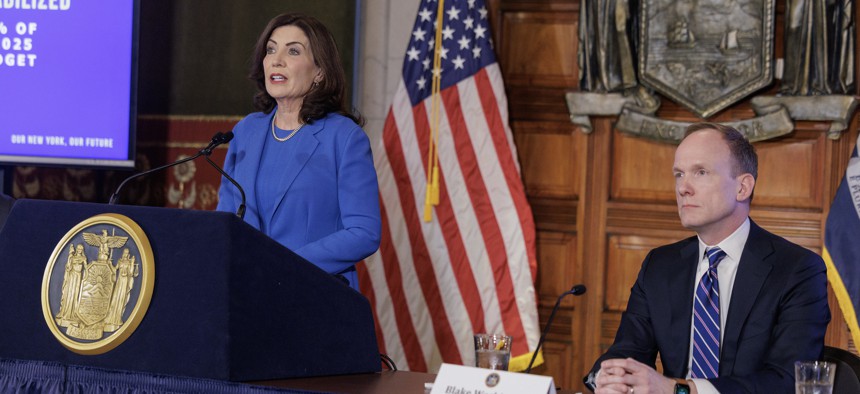Albany Agenda
Hochul’s ‘placeholder’ housing developer tax break
After her previous proposals were rejected, the governor is leaving the most controversial parts of a 421-a replacement for others to decide.

Gov. Kathy Hochul and state Budget Director Blake Washington Mike Groll/Office of Governor Kathy Hochul
Gov. Kathy Hochul is taking another crack at a replacement for the expired 421-a developer tax break to incentivize affordable housing construction in New York City. But she would leave most of the specifics for other people to figure out.
Speaking to reporters after giving her budget address presentation on Tuesday, Hochul described her proposal for a new incentive in New York City as a “placeholder.” With details of the pitch released in a new budget bill, her choice of words seems apt. The new 485-x proposal, named for the section of the law the incentive would exist in, kicks the ball to New York City officials, unions and developers to hash out the most controversial parts of the program after the law takes effect.
Similar to the now-defunct 421-a program, Hochul’s new Affordable Neighborhoods for New Yorkers would create a 35-year tax break benefit period for developers of rental projects that include affordable units, and 40 years for homeownership projects with affordability. But it doesn’t detail the specific levels of affordability and the percentage of affordable units that developers must hit in order to benefit from the tax break. Instead, 485-x leaves that determination to the New York City Department of Housing Preservation and Development – and by proxy, Mayor Eric Adams.
That’s a big difference compared to Hochul’s first attempt to replace the 421-a tax break in 2022, when she proposed the more in-depth 485-w program, which shared the “Affordable Neighborhoods” name with her current pitch. At the time, Hochul proposed multiple affordability options for developers to choose from, and while similar to its predecessor, had slightly deeper affordability requirements than 421-a. Lawmakers didn’t express a desire to accept the proposal and allowed 421-a to expire in 2022, and Hochul did not offer anything new as part of her housing plan last year.
Hochul’s new program would also leave the sticky subject of labor standards to the New York City Building and Construction Trades Council and the Real Estate Board of New York. In the bill language, the largest construction trades and developer trades groups would need to enact a memorandum of understanding by Jan. 1, 2025 in order for the developers to receive tax benefits. When the 421-a program expired in 2016, then Gov. Andrew Cuomo allowed the two parties to duke it out, leading to intense clashes between union leaders and developers for months before they reached a compromise.
Labor standards have also been a big sticking point in finding a compromise in the recent fight to replace 421-a. Construction unions in 2022 did not feel Hochul’s proposal had adequate labor standards and opposed it. When Hochul considered an executive order to create a stopgap extension for the program in 2022 after lawmakers rejected her effort, developers and unions couldn’t agree on labor standards, and unions decried Hochul’s proposal. Ultimately, Hochul unveiled a very limited executive order specifically for projects in the Gowanus neighborhood of Brooklyn, but even that received labor backlash.
Since then, unions have publicly criticized the Real Estate Board of New York for failing to negotiate in good faith and rejecting several compromise proposals. The New York City District Council of Carpenters has been at the forefront of the attacks. In addition to adequate wage agreements, the union also supports new tenant protections as part of any housing deal, which both Hochul and the real estate industry have opposed. “The Building and Construction Trades Council has proposed multiple versions of a new 421-a type program to build housing in New York City,” the Carpenters’ political director Kevin Elkins testified in a December Assembly hearing on housing. “Unfortunately, REBNY rejected all attempts to find compromises.”
REBNY welcomed the new proposal included in the budget. “Governor Hochul has put forth a proposal in the budget to spur much-needed rental housing production and REBNY is committed to working with a broad range of stakeholders, including public officials, labor unions and other advocates to advance this plan,” Real Estate Board of New York President James Whelan said in a statement. “That includes continuing to work with the Building and Construction Trades Council and its constituent unions to pay good construction wages and benefits as part of any new program that spurs the creation of multi-family, mixed income rental housing."
State Senate Labor Committee Chair Jessica Ramos expressed optimism over the requirement for a memorandum of understanding on labor standards, but did not yet throw her support behind the proposal. “It’s encouraging to see that the Governor is compelling real estate to come to the table with labor in order to get these tax breaks, but 485x doesn’t exist in a vacuum,” Ramos said in a statement. “We also need a (project labor agreement) for all (State University of New York) capital projects. We also need to see tenant protections. This is just the start of the conversation.”
Tenant protections also held up housing deals the past two years, and both legislative leaders have reiterated their commitment to including those provisions in any housing package that gets approved. State Senate Majority Leader Andrea Stewart-Cousins specifically mentioned the “principles of ‘good cause,’” referring to legislation that would place restrictions on when a market rate landlord can evict a tenant. Hochul did not include any such proposals in her State of the State address nor in her executive budget.

